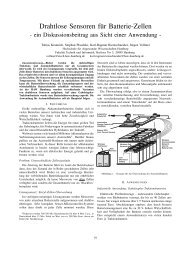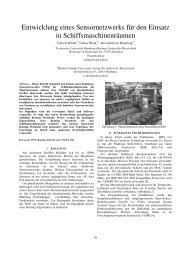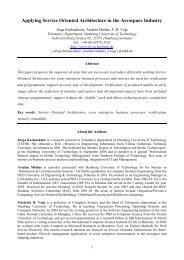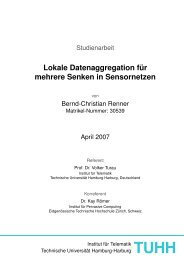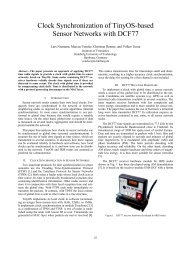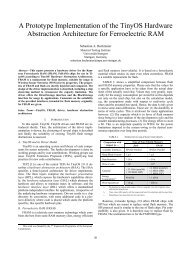Cross-Platform Protocol Development Based on OMNeT++
Cross-Platform Protocol Development Based on OMNeT++
Cross-Platform Protocol Development Based on OMNeT++
Create successful ePaper yourself
Turn your PDF publications into a flip-book with our unique Google optimized e-Paper software.
completely independent<br />
completely independent<br />
User Code<br />
NBH<br />
Rout.<br />
MAC AL<br />
CSMA<br />
Appl.<br />
Rout.<br />
Fork<br />
CometOS<br />
HIL<br />
CometOS Core<br />
Module<br />
InputGate<br />
OutputGate<br />
Message<br />
Object<br />
Scheduler<br />
ATmega128RFA1 other platforms<br />
User Code<br />
NBH<br />
Rout.<br />
MAC AL<br />
CSMA<br />
platform dependent<br />
(a) Hardware <str<strong>on</strong>g>Platform</str<strong>on</strong>g><br />
Appl.<br />
Rout.<br />
Fork<br />
(b) <strong>OMNeT++</strong> envir<strong>on</strong>ment<br />
Module<br />
InputGate<br />
OutputGate<br />
Message<br />
Object<br />
CometOS<br />
Adapter<br />
Figure 1: CometOS Architecture<br />
platform independent<br />
<strong>OMNeT++</strong><br />
machine code instructi<strong>on</strong> level (a per-instructi<strong>on</strong> hardware<br />
emulati<strong>on</strong>). Additi<strong>on</strong>ally, COOJA also enables the simulati<strong>on</strong><br />
of TinyOS code.<br />
3. ARCHITECTURE<br />
A key design goal for CometOS is to provide a lightweight,<br />
flexible and extensible framework for a rapid network protocol<br />
development. Most c<strong>on</strong>cepts are directly adopted from<br />
<strong>OMNeT++</strong>. The core of CometOS comprises the classes<br />
Module, InputGate, OuputGate, Message and Object. These<br />
implement the basic c<strong>on</strong>cepts of <strong>OMNeT++</strong>: message passing<br />
via input and output gates, scheduling of self-messages<br />
and attaching arbitrary objects to message instances.<br />
As shown in Fig. 1, the realizati<strong>on</strong> of CometOS is split<br />
into two major parts. The upper and lower figures show<br />
the architecture for a target hardware and <strong>OMNeT++</strong>, respectively.<br />
Both have in comm<strong>on</strong> that user protocols can be<br />
implemented and executed without porting effort.<br />
Besides user code, the architecture for the actual hardware<br />
platform c<strong>on</strong>sists of a platform-independent core framework<br />
that implements the module and message passing c<strong>on</strong>cept.<br />
This requires a scheduler, which is itself part of a hardwareindependent<br />
layer (HIL). Note that the scheduler interface<br />
is not directly exposed to the user code. Its functi<strong>on</strong>ality is<br />
<strong>on</strong>ly accessible through the Module class. Furthermore, the<br />
HIL provides high-level interfaces for accessing parts of the<br />
target hardware, e.g., the medium access c<strong>on</strong>trol abstracti<strong>on</strong><br />
layer (MAC AL). Details <strong>on</strong> the implementati<strong>on</strong> of CometOS<br />
for a target platform are given in Sect. 3.5.<br />
For the simulati<strong>on</strong> of user code the functi<strong>on</strong>ality of CometOS<br />
is mapped to the infrastructure of <strong>OMNeT++</strong> using<br />
the class adapter pattern. That way, simulati<strong>on</strong>s of protocols<br />
written for CometOS do not differ from dedicated<br />
<strong>OMNeT++</strong> simulati<strong>on</strong>s. Runtime support for inspecti<strong>on</strong> of<br />
modules and messages, locati<strong>on</strong> of undisposed objects and<br />
eventlogging is maintained. If needed, models for simulating<br />
hardware-specific comp<strong>on</strong>ents have to be implemented (e.g.,<br />
MAC AL).<br />
1 using namespace cometos ;<br />
2<br />
3 c l a s s MyMessage : public Message {<br />
4 } ;<br />
5<br />
6 c l a s s MySender : public Module {<br />
7 public :<br />
8 OutputGate gateOut ;<br />
9<br />
10 MySender ( ) :<br />
11 gateOut ( this , ”gateOut ”)<br />
12 {}<br />
13<br />
14 void i n i t i a l i z e ( ) {<br />
15 s c h e d u l e (new Message , &MySender : : t r a f f i c ) ;<br />
16 }<br />
17<br />
18 void t r a f f i c ( Message ∗ t i m e r ) {<br />
19 gateOut . send (new MyMessage ) ;<br />
20 s c h e d u l e ( timer , &MySender : : t r a f f i c , 5 0 0 ) ;<br />
21 }<br />
22 } ;<br />
23<br />
24 c l a s s MyReceiver : public Module {<br />
25 public :<br />
26<br />
27 InputGate g a t e I n ;<br />
28<br />
29 MyReceiver ( ) :<br />
30 g a t e I n ( this , &MyReceiver : : handle , ” g a t e I n ”)<br />
31 {}<br />
32<br />
33 void handle ( MyMessage ∗msg ) {<br />
34 // p r o c e s s message r e c e p t i o n<br />
35 delete msg ;<br />
36 }<br />
37 } ;<br />
Listing 1: Gates and Message Passing<br />
In comparis<strong>on</strong> to <strong>OMNeT++</strong>, CometOS provides less rich<br />
functi<strong>on</strong>ality due to the need of running it <strong>on</strong> resourcec<strong>on</strong>strained<br />
microc<strong>on</strong>trollers, e.g., <strong>on</strong>ly a clock accuracy of<br />
millisec<strong>on</strong>ds is currently provided by each Module. In the<br />
following the main principles are introduced in more detail.



